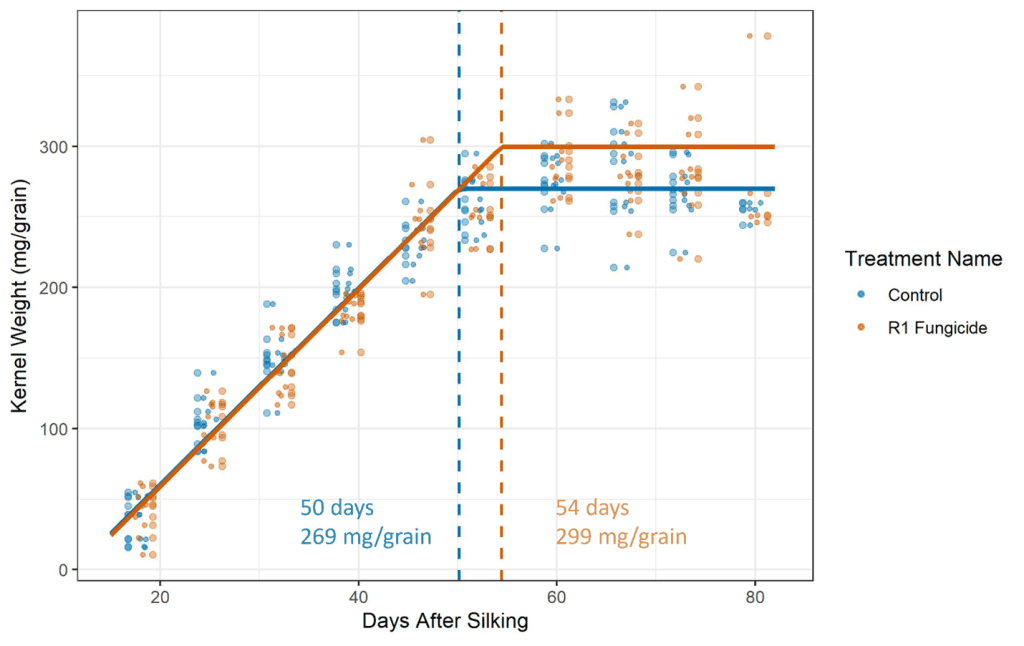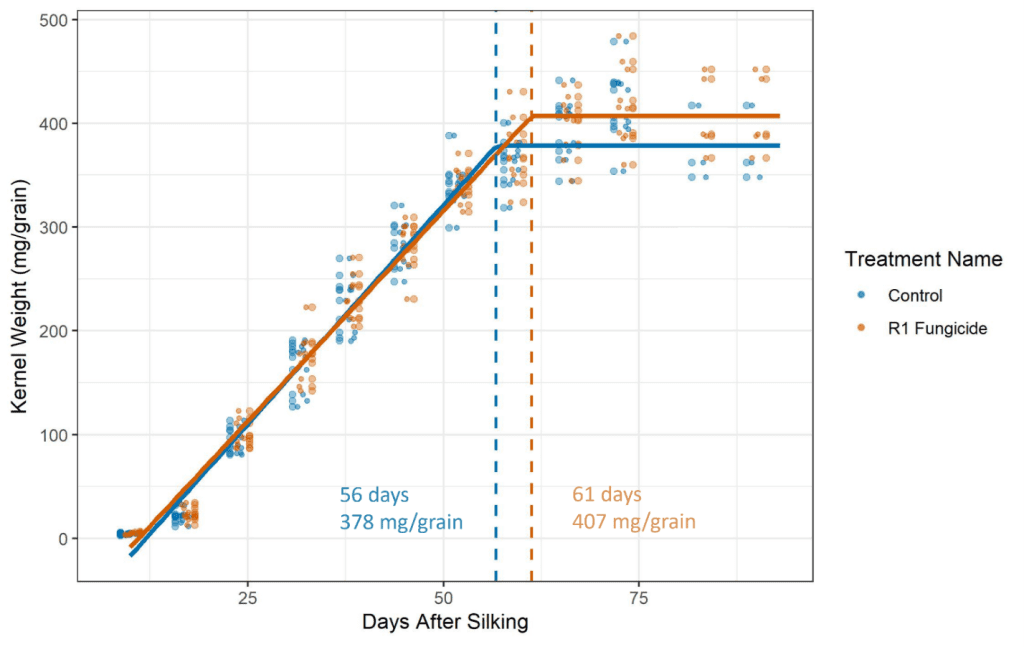Research studies relationship between disease severity reduction and grain fill duration in corn
By Malena Bartaburu
M.S. Graduate Research Assistant, Purdue University
And Dan Quinn, Ph.D.
Purdue Extension Corn Specialist


Optimizing and extending the post-pollination, grain filling period in corn is important for improving grain yield. Overall, this period is critical due to its influence on final kernel size and dry weight. Grain fill duration and kernel weight accumulation in corn is most often a function of both late-season environmental conditions and plant health prior to maturity.
For example, better environmental conditions (e.g., adequate moisture and moderate temperatures) and better plant health (e.g., lack of nutrient deficiencies and plant disease), can result in an extended grain fill period, and corn kernels with higher dry matter levels and overall weight.

Beginning in 2022 and completed in 2023, a research trial at Purdue University and funded by the Indiana Corn Marketing Council (ICMC), sought to further understand how both fungicide use and corn disease control can influence grain fill duration and kernel weight accumulation in addition to just harvest grain yield. The research trial compared corn with and without a foliar fungicide applied at the R1 growth stage (silk emergence).
The study utilized weekly ear sampling techniques to sample, assess and weigh developing corn kernels from the R2 growth stage (milk) to the R6 growth stage (maturity) in order to properly understand how grain fill duration and kernel weight accumulation may or may not be impacted by sufficient disease control. In addition to the weekly ear samples, corn foliar disease severity ratings and final grain yield measurements were collected to further assess the impact of this management practice comparison.
In both 2022 and 2023, the corn research trials were each impacted by foliar disease symptoms, which were highlighted by tar spot, gray leaf spot and northern corn leaf blight. When corn ear leaves were rated at the R5 growth stage (dent) in 2022 and 2023, severity ratings reached 4 percent and 8 percent, respectively, which is a function of the total number of lesions directly impacting the leaf attached to the developing ear.

However, with the inclusion of a foliar fungicide application, ear leaf disease severity was reduced to 1 percent and 2 percent in 2022 and 2023, respectively. The first observation of this research trial further highlighted the potential of a foliar fungicide application in reducing corn leaf disease severity when applied at the R1 growth stage.
However, the further question is, what is the impact of the observed disease control on grain fill duration, kernel weight accumulation and grain yield? In both 2022 and 2023, grain fill duration (days after silking until maximum kernel dry weight was achieved) was extended with an R1 fungicide application and an observed reduction in leaf disease severity (Figures 1 and 2).
In 2022, with the inclusion of an R1 fungicide application, grain fill duration was extended by four days and maximum kernel dry weight from the sampled ears was increased by 11 percent (Figure 1). This result translated to an overall grain yield increase of 19 bushels per acre.
In 2023, similar results were observed (Figure 2), with an observed grain fill duration extension of five days, maximum kernel dry weight increase of 8 percent, and an overall grain yield increase of 11 bushels per acre with the inclusion of an R1 fungicide application.
Overall, this research highlights the potential for improved grain fill duration, kernel weight accumulation, and grain yield when foliar disease is adequately controlled in corn. In addition, this research provided further understanding of the influence of grain fill period extension and maximum kernel weight accumulation on final corn yield.
Furthermore, this research highlights the importance of maintaining and managing late-season corn plant health in order to improve grain fill duration and kernel weight accumulation. Despite these results, it is also important to note that foliar disease was observed in both years of this research trial.
These results were not observed in the absence of disease and/or the absence of observable disease control with a fungicide application. Corn producers still need to maintain informed and targeted foliar fungicide applications in order to maximize yield response, profitability and prevent fungicide resistance.
Posted: July 20, 2024
Category: ICMC, Indiana Corn and Soybean Post - July 2024, News




